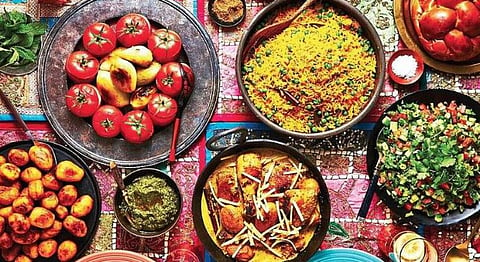
- HOMEGROWN WORLD
- #HGCREATORS
- #HGEXPLORE
- #HGVOICES
- #HGSHOP
- CAREERS
- ABOUT US
- CONTACT US

From being symbols of resistance to becoming an unspoken love language, food has transcended its survival utility to an element that elevates the human experience. As a melting pot for cultures and cuisines, India holds the secrets to communities that were born out of conflict, war, and even struggle.
The Jewish community has been privy to immense resistance and displacement over the last few centuries and the existence of varying Jewish groups in India, traces its arrival from a number of divergent theories. With the Indian Jewish community dwindling to a mere 5000 from the 30,000 people that existed in the mid-60s, much effort has been made to preserve the culture, lifestyle, and particularly the collaborative cuisine that emerged from the amalgamation of the two communities.
Writer Esther David in her latest culture-cookbook, Bene Appetit: The Cuisine of Indian Jews talks about the importance of preserving the essence of a community that is fast disappearing.
“There are 5,000 Jews in India, down from about 30,000 at the peak in the mid-1950s and 1960s. When a community decreases in numbers, its traditional food starts to disappear.”
— Esther David, author of Bene Appetit: The Cuisine of Indian Jews
India’s last remaining Jews are further divided into five main groups based on their geographical settlement. The Bene Israel, Cochin Jews, and Baghdadi Jews are the three of the largest Indian Jewish communities to exist in the country. The proximity to the ocean and other water bodies cast a significant influence on their cuisine.
The community is strictly bound by Kosher laws which forbid the mixing of dairy and meat products amongst other bylaws. This urged the community to incorporate vegetarian elements into its diet, making it evolve and distinct. Here’s all you should know about the food of these dwindling communities that hold a rich cultural heritage that speaks for itself.
I. Bene Israel: The Jews of Bombay
These descendants from Palestine claim to have reached Indians shores as a result of a ship wreck, the remains of which washed up on the Indian Ocean. The 14 members on the ship were cast ashore on the Konkan peninsula on a strip of land that is now Bombay. Over the centuries, the isolation from the rest of the city’s communities urged this group of survivors to adopt the local language, Marathi.
This unique community of Jews were primarily oil-pressers and agriculturists whose food was majorly influenced by Maharashtra’s local cuisine as well. Coconut milk, hot chili, cardamom, cinnamon, turmeric, ginger, cumin, coriander, and garam masala became essential ingredients that were found in almost every dish.
Some of the more popular dishes include coconut karanjis, a stuffed, fried pastry with a coconut and dry fruit filling, naaral halwa, a dessert made out of diluted coconut milk and other seafood delicacies that primarily use paplet (pomfret).
Café Zoe in Lower Parel, Kosher Mumbai in Colaba and Kosher bakery in Worli are some of the last-standing kitchens that are trying to keep the community’s heritage alive in the city.
II. Cochini Jews
This was the one of the first communities of Jews to enter India and occupy the state of Kerala. The Cochini Jews are further divided into three subcategories: the Malabari jews (referring to the proximity to the Malabar coast), the Pardesi (foreign) Jews and the Meyuhassim (Hebrew for privileged) Jews. The last group however is the largest, in terms of population.
Rice is still the predominant staple diet for most South-Indians especially Malayalis. The Cochini Jews, took, adopted this crop as a major part of their cuisine. Parboiled rice and specifically coconut rice is a particularly distinct but vital part of a Cochini meal.
During the annual passover season that Jews all over celebrate, they follow a simple, kosher diet that involves some fusion foods including, Charoset, a sweet, brown, pebbly mixture made with dates and Kai Oram, a roasted chicken wing.
Cochin is probably the last standing city with an active synagogue-going Jewish population. Jew Town in Cochin offers a variety of Kosher food restaurants and cafes amongst which Menorah Restaurant is a must-visit suggested by locals.
III. Baghdadi Jews
As the name suggests, this community of Indian Jews migrated from Baghdad to India and settled in pockets around present-day Ahmedabad and Kolkata. With a strong influence of the Middle-East, Baghdadi Jewish cuisine became an amalgamation of the two geographical locations with religious influences to it.
Potatoes form the core of every meal and delicacies like Alu makallah (Deep-fried Potatoes) became wildly popular even amongst the locals living in the vicinity. As a Friday night speciality, potatoes are often served with chicken, fenugreek chutney and vegetables.
Baghdadi Jewish food witnessed a shift in its palette as it witnessed an emerging trend of spicy dishes which is other absent in common Jewish meals.
Nahoum’s bakery, a 120-year old establishment serves the best that this cuisine has to offer right from plum cakes to cheese muffins, brownies and rum balls.
If you enjoyed reading this, we also suggest:
